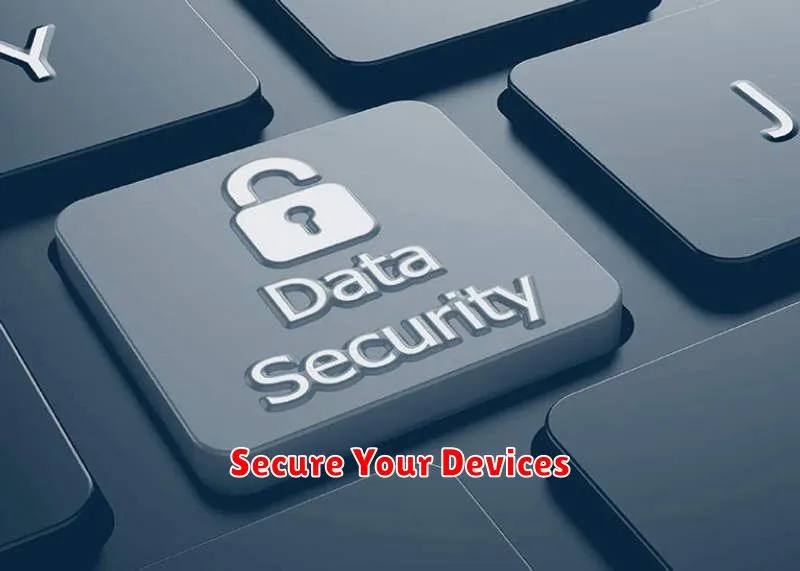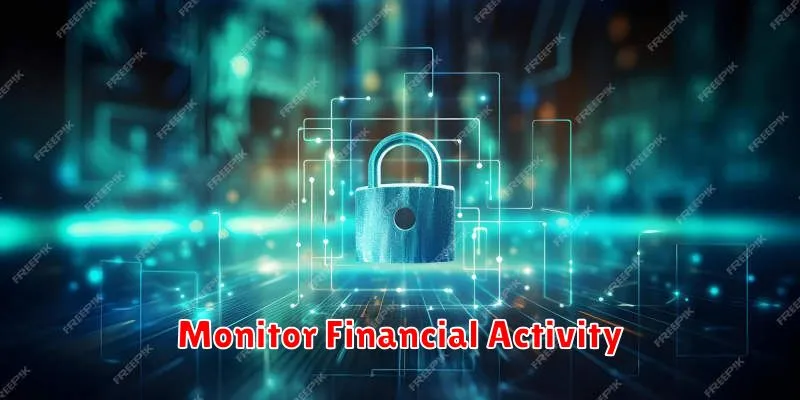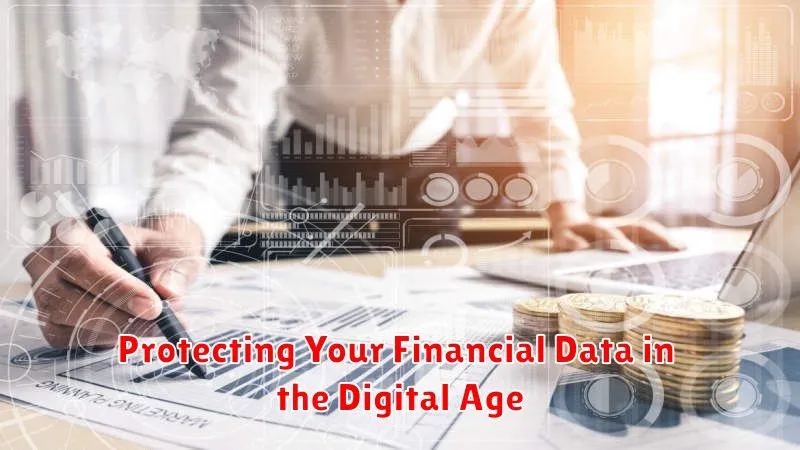In today’s interconnected world, protecting your financial data is more critical than ever. The digital age presents unprecedented opportunities for convenience and access, but it also brings significant risks. From online banking and shopping to mobile payments and cryptocurrency investments, our financial lives are increasingly intertwined with the digital realm. This reliance on digital platforms necessitates a heightened awareness of potential threats and the implementation of robust security measures. Understanding the landscape of digital financial security is the first step toward safeguarding your sensitive information and preventing financial fraud. Learn how to protect yourself from identity theft, phishing scams, and other cyber threats that can compromise your financial well-being.
This article will explore the essential steps you can take to protect your financial data in the digital age. We will delve into the various security measures you can employ to mitigate risks and safeguard your financial information. Topics covered will include creating strong passwords, recognizing and avoiding phishing scams, practicing safe online banking habits, securing your mobile devices, and staying informed about the latest cybersecurity threats. By understanding and implementing these protective measures, you can significantly reduce your vulnerability to financial fraud and identity theft, ensuring your financial well-being in the increasingly complex digital landscape. Take control of your financial security and learn how to navigate the digital age with confidence.
Understand Common Security Threats
Phishing attacks attempt to trick you into revealing sensitive information like usernames, passwords, and credit card details by posing as a legitimate entity. Be wary of suspicious emails, text messages, or phone calls.
Malware is malicious software designed to damage or disable your computer systems. It can steal your data, monitor your activity, or give attackers control of your device. Ensure you have up-to-date antivirus software installed.
Data breaches occur when unauthorized individuals gain access to sensitive data held by organizations. While you can’t prevent all data breaches, you can monitor your accounts for suspicious activity and take prompt action if compromised.
Regularly Update Passwords
One of the most effective ways to safeguard your financial information is to regularly update your passwords. This simple practice significantly reduces the risk of unauthorized access, even if a password has been previously compromised.
Experts recommend changing passwords every three to six months. Avoid using easily guessed passwords like birthdays or pet names. Instead, opt for strong passwords that include a combination of uppercase and lowercase letters, numbers, and symbols. A password manager can be a valuable tool for generating and securely storing complex passwords.
Never reuse the same password across multiple accounts, especially for sensitive financial platforms. If one account is compromised, all accounts using that password become vulnerable. Consider implementing two-factor authentication (2FA) wherever possible for an added layer of security.
Secure Your Devices

Securing your devices is paramount to protecting your financial data. Strong passwords are the first line of defense. Create unique, complex passwords for each account, and consider using a password manager to securely store them. Enable two-factor authentication (2FA) whenever possible for an added layer of security. This requires a second verification method, like a code sent to your phone, in addition to your password.
Keep your software updated. Regularly install operating system updates and app updates to patch security vulnerabilities. Avoid using public Wi-Fi for financial transactions, as these networks can be insecure. If you must use public Wi-Fi, consider using a virtual private network (VPN) to encrypt your connection.
Enable Multi-Factor Authentication
One of the most effective ways to enhance your online security is by enabling multi-factor authentication (MFA). MFA adds an extra layer of security by requiring more than just your username and password to access your accounts.
Typically, MFA involves receiving a unique code via text message, email, or an authenticator app on your smartphone. This code is then entered alongside your password to verify your identity. Even if your password is compromised, the hacker would still need access to your second authentication factor, making it significantly more difficult to breach your accounts.
Many financial institutions and online services offer MFA. It is highly recommended to enable this feature whenever available. This simple step can dramatically reduce the risk of unauthorized access to your sensitive financial information.
Avoid Phishing Attacks
Phishing attacks are designed to trick you into revealing sensitive information like usernames, passwords, and credit card details. Be wary of suspicious emails, text messages, or phone calls that ask for personal information.
Verify the sender’s identity before clicking on any links or opening attachments. Look for misspellings, grammatical errors, and unusual email addresses, which are common signs of phishing attempts. Don’t respond to unsolicited requests for financial information. Legitimate organizations will never ask for your password or credit card number via email or text.
Review Privacy Settings Frequently
Regularly reviewing your privacy settings is crucial for maintaining control over your financial data. The digital landscape is constantly evolving, with platforms frequently updating their policies and features. This means your initial privacy configurations may become insufficient over time.
Make it a habit to revisit the privacy settings of your online banking portals, financial apps, and social media accounts. Look for options related to data sharing, transaction visibility, and account access. Strong passwords and two-factor authentication should also be reviewed and updated periodically.
Use Secure Networks for Transactions
Avoid using public Wi-Fi for financial transactions. These networks are often unsecured, making your data vulnerable to interception by cybercriminals. Always opt for a secure network when accessing financial accounts or making online purchases.
Look for the lock icon in your browser’s address bar and ensure the website address begins with “https.” This signifies a secure connection, encrypting data transmitted between your device and the website.
Consider using a virtual private network (VPN) for added security, especially when using public Wi-Fi. A VPN encrypts your internet traffic, creating a secure tunnel for your data and masking your IP address.
Regularly Backup Your Data
One of the most critical aspects of protecting your financial data is creating regular backups. Data loss can occur due to various reasons, including hardware failure, software corruption, accidental deletion, or even cyberattacks. Backups provide a safety net, allowing you to restore your information should the unthinkable happen.
Consider using the 3-2-1 backup strategy: three copies of your data on two different media, with one copy stored offsite. This approach ensures redundancy and protects against a wide range of potential data loss scenarios.
Frequency is key. Regularly backing up your data minimizes the potential impact of data loss. Determine a backup schedule that aligns with the frequency of your financial activities. For some, this may be daily, while for others, weekly backups may suffice.
Educate Yourself About Cybersecurity
In today’s interconnected world, safeguarding your financial data requires a proactive approach to cybersecurity. Education is your first line of defense. Understanding the basics of online threats can significantly reduce your risk.
Familiarize yourself with common attack vectors such as phishing emails, smishing texts, and vishing calls. Learn to identify suspicious links and attachments. Never click on anything you are unsure about. A healthy dose of skepticism is essential.
Strong passwords are crucial. Utilize a combination of uppercase and lowercase letters, numbers, and symbols. Consider using a reputable password manager to securely store and generate complex passwords. Multi-factor authentication adds another layer of protection whenever possible.
Monitor Financial Activity

Regularly monitoring your financial accounts is crucial for protecting your data. This allows you to quickly identify and address any suspicious activity.
Check your bank and credit card statements frequently, ideally weekly or even daily if possible. Look for any unauthorized transactions, however small.
Utilize online banking and mobile apps provided by your financial institutions. These tools offer real-time access to your accounts and often include transaction alerts. Set up alerts for unusual activity such as large withdrawals, international transactions, or address changes.

